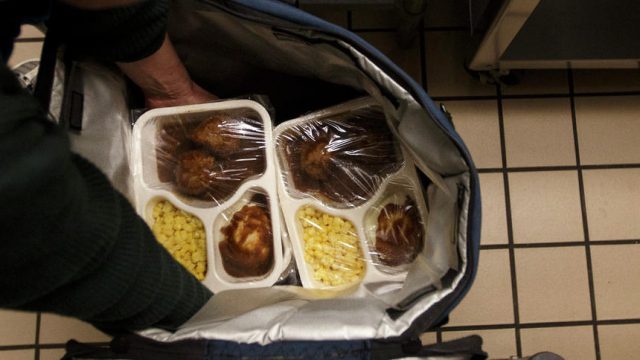Can We Please Please Start Talking About the Meals on Wheels Issue Accurately?

Liz Lindquist loads up an insulated bag with porcupine meatballs, mashed potatoes and corn meals for one of the route drivers on Wednesday, March 22, 2017 in Grand Forks, N.D. (Jesse Trelstad/Grand Forks Herald)
As North Dakota’s lawmakers work towards finalizing budgets we’re getting a lot of sad, sad headlines about the (often exaggerated) consequences of cutting spending. Which is to be expected.
There hasn’t been a government bureaucrat hired yet who wasn’t prone to histrionics when faced with a reduced budget. Or even just the reality that they won’t be getting as large a budget increase as previously expected.
The latter is the case in the debate over the state’s Meals on Wheels program. Partisan left-wing interests have been suggesting that the spending for the program is being cut. Except, it’s not.
The program is funded by federal, state, local, and recipient dollars. The feds pay a bit of a third of the cost of each meal. The state pays a little over 20 percent, and the counties pay about 15 percent. The rest is paid for by the meal recipients who pay about $2.50 per meal.
The program delivered 1.12 million meals to some 19,000 seniors last year, including 512,000 meals delivered to 5,200 seniors in their homes.
Last year the State of North Dakota sent $3,493,688 to the counties for the meals. Down in Bismarck lawmakers are proposing capping spending on the program at $3.5 million, or basically at the level it is at today. The program, which gets automatic spending increases, was expected to cost the state $3.9 million in the next year in matching funds.
Hyperbolic Democrats are claiming that holding spending on the program even amounts to a $400,000 cut.
.@NDHouseDemNPL is fighting to protect Meals on Wheels, which is necessary for seniors, rural communities. #ndpol https://t.co/61BqGoDCLc pic.twitter.com/ub7yFlLUYa
— ND Dem-NPL (@nddemnpl) March 23, 2017
But a failure to increase spending, whatever you may think of that policy, is not a cut.
That’s a claim repeated, unfortunately, by the Bismarck Tribune today. “One program being considered for reductions both nationally and in the state is Meals on Wheels,” an editorial published today reads.
That’s baloney. There is no reduction. There is no spending cut. If anything there is a slight increase in funding.
I suppose you can argue that the costs of the program might increase. Fuel prices go up. The number of recipients may increase too. Those are fair points to make, but they do not change the simple reality that lawmakers are not reducing funding for this program.
By the way, if proponents of this program want revenues to grow, why not adjust the cost of the meals to recipients? There is some room there to grow. Again, right now meal recipients are paying $2.50 per meal. If they were to pay, say, $3.00 per meal that would produce another $560,000 in revenue based on the 1.12 million meals served by the program last year.
That’s a dollar figure which is larger than the state’s projected increase in spending.
The cost to meal recipients? About $15 per month more or less depending on the number of meals they receive.
I know, I know. The people who participate in these programs don’t have a lot of money, but a cost of $3.00 per meal is still extremely cheap.
The state’s budget is tight right now. There is little room for expanded spending. But there is clearly some room for increasing the user fee for these meals. Why not go that route? Sure, the partisan liberals are going to scream and cry about “balancing the budget on the backs of seniors,” but why should we let such demagoguery get in the way of good policy?




